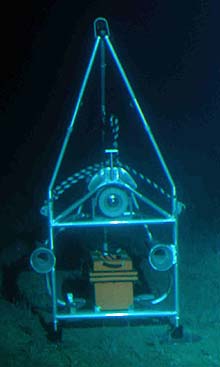
The innovative Eye-in-the-Sea is a self-contained underwater camera system able to observe animals and their natural behaviors unobtrusively. It operates with red lights and an image intensifier that works something like night-vision goggles.
Eye-in-the-Sea: An Innovative, Unobtrusive Camera System
Mark Schrope
Science Writer
Harbor Branch Oceanographic Institution
The deep sea makes up about 78% of the planet's inhabitable
volume, but little is known about most of its inhabitants -- including those that can make their own light, or bioluminescence. This scientific deficiency
stems not only from
a lack of ocean exploration and study, but also
from less-than-ideal traditional research methods.
Some of these methods actually create problems, such as injury to specimens and/or interference with their natural behavior during research. Deep-towed
nets, for example, can shred animals, such as jellyfish, or damage captured animals
to the point that their natural behaviors cannot be observed in
the lab. Manned submersibles and remotely operated vehicles (ROVs) -- which are essential to deep sea research -- bring with them lights, motors, and electric fields that either scare animals away before
they're ever seen, or frighten them into unnatural behavior.
Dr. Edith Widder wanted a solution to these problems. She dreamed of, then created, an innovative, unobtrusive camera system to record life in the abyss. Called Eye-in-the-Sea, the system operates automatically on the sea floor. Most importantly, however, it is designed to go unnoticed by animals. The system uses bioluminescence to its advantage. It can detect animals nearby when they give off bioluminescent light, trigger a video camera to record the light being produced, then turn on a red light out of the animals' normal vision range. The result: the collection of illuminated footage, without alerting the subject or scaring it away.
The system can also be programmed to film surrounding
areas at scheduled intervals. (This feature will be useful, for instance, when Dr. Widder
and her team place the system on the bottom, along with bait to
attract animals). In the past, camera systems used on the sea floor
have relied on bright lights, which frighten those creatures accustomed to the
darkness of the deep.
Dr. Widder and her colleagues also developed Eye-in-the-Sea's ability to capture new
animals and behavior on film. A simple electronic device, deployed
with the system, mimics the various bioluminescent light patterns
given off by jellyfish, known as Atolla. Various Atolla species
are common in the deep sea; their round bodies, when viewed from above, look something like a tie-dye splotch. The artificial jellyfish lure is a disc, about six inches across, with a ring of blue LED lights around its outer
edge. The lights can be programmed to light up in patterns similar to those the jellyfish create.
How and why do jellyfish and other animals use their
bioluminescence?
Dr. Widder uses the lure to test hypotheses. For instance, jellyfish sometimes
respond to threat by creating a circular "wave" of light
around their outer edge that progresses like the lights on a movie marquee. Scientists call
this a "burglar alarm" response and theorize that jellyfish
use it to attract large animals in to eat whatever animal is attacking
the jellyfish. To test that theory and others, the
team deploys Eye-in-the-Sea next to a box of bait -- along with the artificial
jellyfish programmed to produce various displays -- to see how animals
in the area respond. The jellyfish lure can also attract large predators
to the area, which are captured on film.























